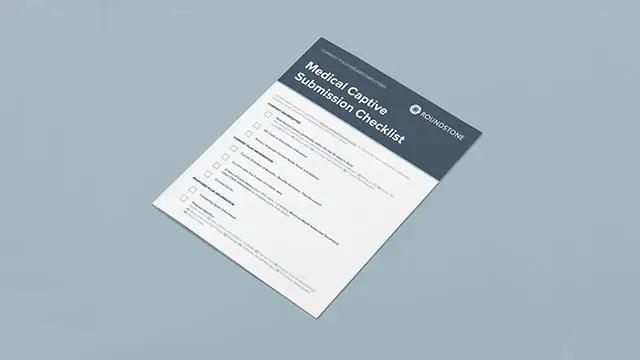Highlights
- What is self-funded health insurance? This is an innovative solution for small businesses looking for affordable health insurance for employees. This and other Frequently Asked Questions (FAQs) on self-funded health insurance are answered here.
- Understanding the benefits of self-funded health insurance can help you build an affordable, high-quality employee benefits plan.
- Joining a group captive plan can help you realize the advantages of self-funding as a small to mid-size company.
Small to midsize companies looking for a better, more affordable health insurance plan for their employees may have heard of self-funded insurance. Traditionally, it was the go-to solution only for Fortune 500 companies who could afford it. However, innovative approaches like Roundstone’s Group Medical Captive have made this an affordable and viable option for small to midsize businesses who wish to lower their health insurance costs while providing top quality care that attracts premium talent.
Yet many leaders and HR professionals are unfamiliar with the basics of a self-funded employer health plan and need to know what self-funded insurance is before switching their plan.
In this blog, we will explain what is self-funded health insurance and why this innovative approach can save small businesses hundreds of thousands of dollars annually in health insurance costs through a group medical captive. We will also answer many of the most common questions – a handy FAQ reference for anyone looking to learn the fundamentals of self-insurance.
Self-Funded Health Insurance FAQs
If you’re curious about implementing a self-funded health insurance plan, you can explore the basics of how it works and how it saves your members money to determine if it’s right for you. The following FAQs explain what is self-funded health insurance. They can help you and your team understand self-funding and how it can benefit your plan members.
What is Self-Funded Health Insurance?
Self-funded or self-insurance is a type of health insurance in which an employer takes on the financial expense of providing healthcare benefits to employees. Instead of paying premiums to a fully insured provider, self-funding requires the employer to set aside funds to pay for healthcare costs.
Traditionally, self-insurance has only been available to large corporations with the funds to pay for healthcare claims. However, group captive insurance allows smaller companies to join together to share the risk while realizing the benefits of a self-funded plan. Through this innovative approach, smaller companies can afford the savings and benefits Fortune 500 companies have enjoyed for generations.
What’s the Difference Between Self-Funded vs. Fully Insured?
The differences between self-funded and fully funded insurance are risk management and plan design flexibility. With traditional insurance, the insurer assumes the risk for healthcare claims, takes on the administrative duties of plan management, and designs the plan elements, including which pharmacy benefit manager (PBM) and network providers to use.
With self-funded insurance, the employer handles these responsibilities. However, companies that use self-funding typically take out a stop-loss policy to mitigate risk and work with their choice of third-party administrator (TPA) to handle claims processing. This simplifies the process on the part of the employer, who leaves the details to a trained and experienced professional.
Self-funding also lets the company design their plan from scratch, allowing for freedom and flexibility in choosing vendors and providers. This way they can optimize savings while improving care quality, essentially creating a custom care plan tailored to their employees’ unique needs.

What’s the Difference Between Self-Funded and Level-Funded Insurance?
Level-funded insurance is similar to self-funded insurance in that employers with a level-funded plan use a TPA to process claims, pay premiums based on claims projection from a stop-loss policy, and have the potential for refunds on unused premiums.
However, unlike self-funded plans, level funding does not allow for bottom-up plan design. Instead, the employer chooses a pre-designed plan and has no control over PBM, TPA, or providers. Additionally, unlike a self-funded plan, you may only see a string-attached refund of less than 50% of your excess claims funds. And often you don’t get any money back until you agree to a renewal, so you are effectively stuck with the plan unless you say goodbye to those savings.
In effect, level funded health insurance ends up being the worst of both models. The insurer keeps a good portion of the money that would ordinarily come back to you, and you don’t have access to the data and oversight to custom design a plan that works works for you.
Why Do Companies Self-Fund Their Health Insurance?
Self-funded health insurance is extremely popular. Among large firms, over 82% of workers are covered by self-funded health plans. The reason is very simple: It’s cheaper and provides higher quality care. Companies only pay for what they need. They only pay for the direct costs of healthcare and can avoid the spiking premiums that have ravaged the fully-funded insurance industry.
Traditionally, only large corporations have been able to offset the risk of self-funded plans. The first of its kind, Roundstone’s Group Captive Model allows small to midsize companies to also enjoy the benefits and savings of self-insurance by pooling together to offset the risk. 100% of our clients save money through self-funded insurance under Roundstones Group Captive Model. Two-thirds of our customers save enough in their first four years with us to pay the claims for their entire fifth year.
That’s why we offer the Roundstone guarantee – you’ll save money in the first five years with Roundstone over a fully-insured plan or the difference is on us.
What Are the Benefits of Self-Funded Health Insurance?
Self-funded insurance offers plenty of benefits for employers, including plan customization, cost savings opportunities, cash back, and data transparency.
Advantages of self-funded health insurance include having complete control over your plan design. This allows you to implement cost containment strategies for up to 85% of plan expenses, which lowers premiums and out-of-pocket costs for employees. You end up with a better plan custom suited to your employees’ needs that also saves you money.
Self-funded plans let you choose your TPA, PBM, vendors, and provider network. They also provide access to claims data so you can make the best choices for your members. You gain complete visibility into claims and can identify opportunities to actively manage costs and optimize plan utilization. Flexible funding options allow you to fund projected costs based on your cash flow and budgeting preferences or pay claims as you go.
For example, if you notice high urgent care costs, you can start a direct primary care program for preventative screenings to mitigate UC or ER visits. You can also manage risk by paying for your employees’ claims up to your custom deductible and sharing most risk with other employers for claims over your deductible while shifting high-cost catastrophic risk to stop-loss insurance.
Best of all, with self-funding, you get 100% of unused premiums back at the end of the year, whether or not you renew, unlike a level funded plan. When you receive this annual distribution of unspent premiums you can use it to implement new coverages or put it in the bank – it’s up to you.
Are Self-Funded Health Insurance Plans Subject to ERISA?
ERISA, or the Employee Retirement Income and Security Act of 1974, is a federal law that protects most private employee pension and health plans from mismanagement and fraud.
Most self-insured private employer health insurance plans fall under ERISA. The exceptions are self-insured health plans sponsored through school districts, certain municipalities, and churches. Members of these plans can file a complaint with the plan directly or through a court of law.
ERISA doesn’t set rules for what kinds of benefits are provided or how many. It merely sets rules for management of the health plan, typically for reporting and providing information. Under ERISA, employees must be provided a summary plan description of the plan’s premiums, deductibles, and copays. Employers must file an annual federal government report and maintain certain standards, including nondiscrimination in premiums and eligibility.
How are Self-Funded Health Insurance Plans Taxed?
Unlike traditional fully insured health insurance, self-funded plans do not pay state premium taxes, which would otherwise average 2 to 3% of the premium’s dollar value. These costs are typically baked into the quotes of a fully insured plan, and many employees are unaware they pay them. Self-insurance plans’ exemption from state tax is another reason why it is the more affordable option.
Self-funded plans are also exempt from most state insurance laws. Because most self-funded plans are customized to optimize savings while enhancing care, they are also exempt from associated fees and compliance audits. The exemptions afforded to self-insurance plans further reduce the costs and complexities of the model.
How Does a Self-Funded Group Stop-Loss Captive Work?
A self-funded group stop-loss captive works by switching from a fixed to a variable pricing structure. This means that members only pay for what their employees use, and any unused funds are returned at the end of the year.
Every year, Roundstone writes checks in the tens of thousands of dollars to their clients as refunds in unused funds. In 2022, Roundstone distributed $24.4M unspent captive premium pro rata.
There are three aspects to a self-funded group captive plan: self-funded claims, shared risk, and transferred risk. Self-insured employers pay for all out-of-pocket claims when they occur, while employers pay premiums to the captive pool for claims ranging between the deductible amount and $500,000.
A stop-loss policy covers claims above the plan’s retained claims to protect against unpredictable losses and prevent the captive participants from paying more than the maximum amounts presented in their proposal.
What’s the Difference Between Self-Insurance and Captive Insurance?
Self-insurance occurs when a business assumes all the costs incurred with insuring their employees. It’s a more affordable model because a business only pays for what it needs. But it can be risky for small to midsize businesses if something catastrophic happens to one or more of their employees. They’re left assuming all the risk. Traditionally, this option was only viable for large companies of 1,000 or more employees who can offset that risk.
Self-funded health insurance under the group medical captive model pools several small to midsize businesses together in order to make self insurance an affordable and viable option. By combining resources, these companies are able to use their solidarity to offset the risk. They only pay for what they need. They also gain data-rich insight into their plans so they can tweak policies to maximize care quality while lowering cost. The end result is a cost-effective approach that enhances the quality of care provided.
Founded in 2005, Roundstone’s Group Medical Captive was the first of its kind. It revolutionized the healthcare space by empowering small to midsize businesses to take advantage of the quality and savings available with a self-funded model, which formerly had only been entitled to large corporations.
In fact, two-thirds of our clients save enough money in their first four years of self-funding under our Group Captive model to completely pay for their fifth year of claims.

What Are the Advantages of a Group Health Captive?
There are several benefits of captive insurance. A group health captive allows for greater control over healthcare costs, as companies can customize their plans to suit the needs of their employees and negotiate better rates with providers.
Captives also minimize risk and provide greater stability and predictability in pricing, as the group shares the costs and risks of healthcare claims. Group captives also offer the opportunity to earn underwriting profits, as any surplus funds generated can be retained by the group rather than being returned to an insurance carrier.
How Does Stop-Loss Insurance Work?
Stop-loss insurance under a group medical captive plan allows small to midsize businesses to better absorb losses during a bad claims year. It’s designed for employers who self-fund their health insurance but want to avoid the risk of assuming 100% liability for catastrophic claims.
You pay outright for claims up to a certain deductible, typically anywhere from $10,000 to $25,000. This is 65% of the cost of your self-insurance plan. Once that deductible is reached, the claims are then paid out of the Roundstone Group Medical Captive, which typically will cover claims up to $500,000. Stop-loss insurance then covers claims over $500,000. It is 10% of the total cost of your self-funded insurance plan. Stop-loss insurance protects an employer’s financial reserves and their bottom line.
There are two types of stop loss insurance: specific stop loss insurance and aggregate stop loss insurance. Also known as individual stop loss insurance, specific stop loss insurance provides risk coverage against high claims on an individual. Aggregate stop loss insurance covers the total claims of all members, rather than individual claims. When total claims go above the aggregate limit, the insurer reimburses the company.
Stop-loss insurance works to provide employers protection against unusually high claims from individuals and/or a high claims frequency for all employees covered under the policy.
What is a PBM?
A PBM is a pharmacy benefits manager who administers prescription drug benefits. They work with drug manufacturers, pharmacies, and drug wholesalers to provide prescription medication under the contract price. Choosing the right PBM can substantially reduce pharmacy spend.
Under a fully insured plan, you are already using a PBM – only you don’t get to choose the pharmacy benefits manager who could benefit you the most. Traditional PBMs pocket the savings they generate as additional profit.
But with a self-funded insurance model, you can choose a transparent PBM who is open about their fee structure, making it easier to track where their revenue comes from. This way, you can be sure to work with a pass-through pharmacy benefits manager who passes the savings from manufacturer’s coupons on to you, so you can be sure you benefit from the savings. The right PBM understands the system and how to get the best savings on a particular drug and ensures those savings are shared with you.
What is a TPA?
A TPA is a third-party administrator that provides administrative services for self-funded health insurance plans. They’re like an HR department for your insurance. If you have any issue or concern, they’re the ones who solve it. They adjudicate claims and work with healthcare providers to ensure optimized savings and uncompromised care.
A TPA differs from an ASO, which is a wholly-owned subsidiary of an insurance company. An ASO may limit your network provider options and has limited services. TPAs, on the other hand, typically offer several PPO networks to choose from, so your employees enjoy a wider range of options for care.
Best of all, a TPA reduces the burden on your HR department by assisting with open enrollment for your plan. They can also help facilitate communication materials and host onboarding events.
A TPA can help navigate the confusing world of insurance coverage. They ensure you always get the most bang for your buck.
Is Self-Funded Health Insurance Good for Employees?
Self-funded health under the group captive model provides numerous advantages for employees. First, companies only pay for the insurance they need. This helps them avoid skyrocketing insurance costs that continue to rise every year and inevitably get passed onto employees.
Second, self-funded health insurance provides detailed data into your insurance expenses. You can therefore tweak the plan in a way that minimizes expenses while maximizing care quality, effectively providing a higher quality plan for less money.
Your employees end up paying less for their health insurance, which would otherwise offset any raises or bonuses afforded to them. You can effectively provide your employees a higher-quality insurance program at a lower rate.
Research has found that employees who are highly satisfied with their healthcare benefits have double the retention rates. Self-funded health insurance allows you to attract premier talent and enjoy a highly dedicated and satisfied workforce.
What is Cost Containment in Healthcare?
Cost containment is a strategy to make healthcare cost less by lowering costs without compromising care quality. This can be done through payment integrity – ensuring the bills patients receive are accurate and free of erroneous charges. Another approach uses referenced-based pricing which uses a benchmark of prices for services rendered to negotiate lower payments for services and procedures. This approach works like comparison-based shopping for lower prices.
The beauty of self-funded insurance plans is you have control over plan design. It provides transparency into what is driving up plan costs so you can take action to reduce spend. You can tailor cost containment solutions to drive down costs while ensuring a high integrity of care. Claims data can be reviewed, and the plan adjusted to reduce spend. A PBM can work with you to customize pharmacy solutions best tailored to your needs while reducing costs.
What is Collateral in a Self-Funded Health Insurance Plan?
Collateral is the contribution an employer makes in the Group Medical Captive to cover liabilities exceeding collective premium. The collateral will earn investment income and may remain intact and potentially refundable, depending on the extent of the captive’s claims during the underwriting year.
Collateral funds the Group Medical Captive’s assumed risk above the premium. It ensures all potential losses are funded upfront. Participants are not required to contribute additional funds.
Payment of the collateral ensures participation in the Group Medical Captive which allows you to share in the underwriting profit of the captive and realize investment income on both the collateral and Captive Risk Premium.
Experience the Benefits of Self-Funded Health Insurance With Roundstone
Self-funded, group captive insurance can help your company provide high-level benefits to your members while also saving you money on health insurance costs.
Speak with a Roundstone Advisor today to learn more about the benefits of self-insurance for your employees and how to get started with a group captive plan.











